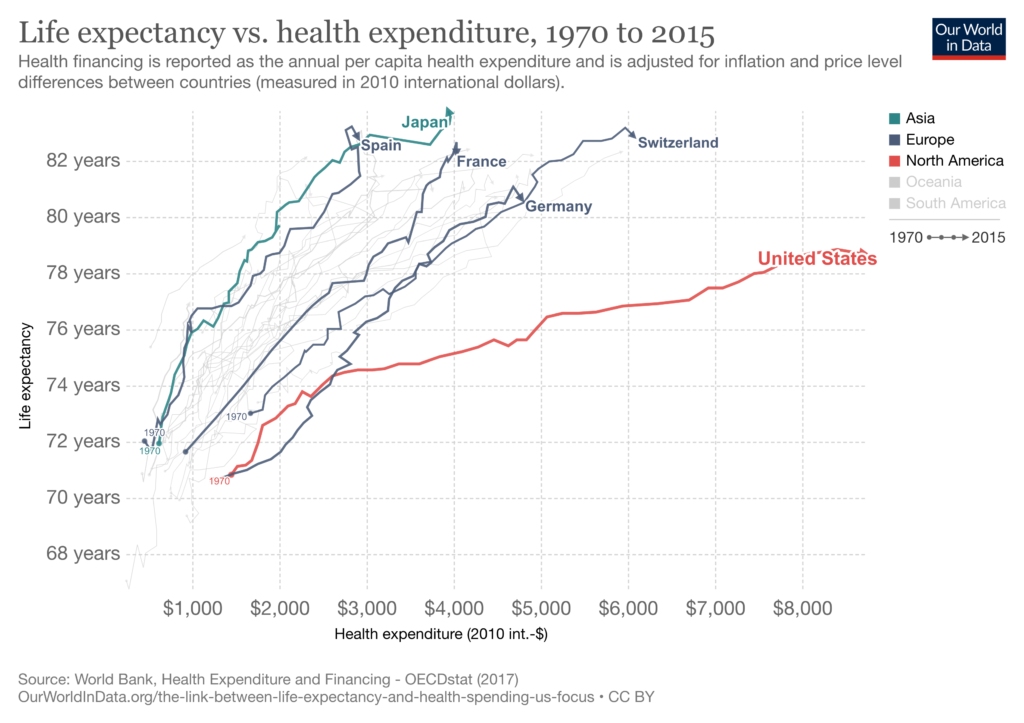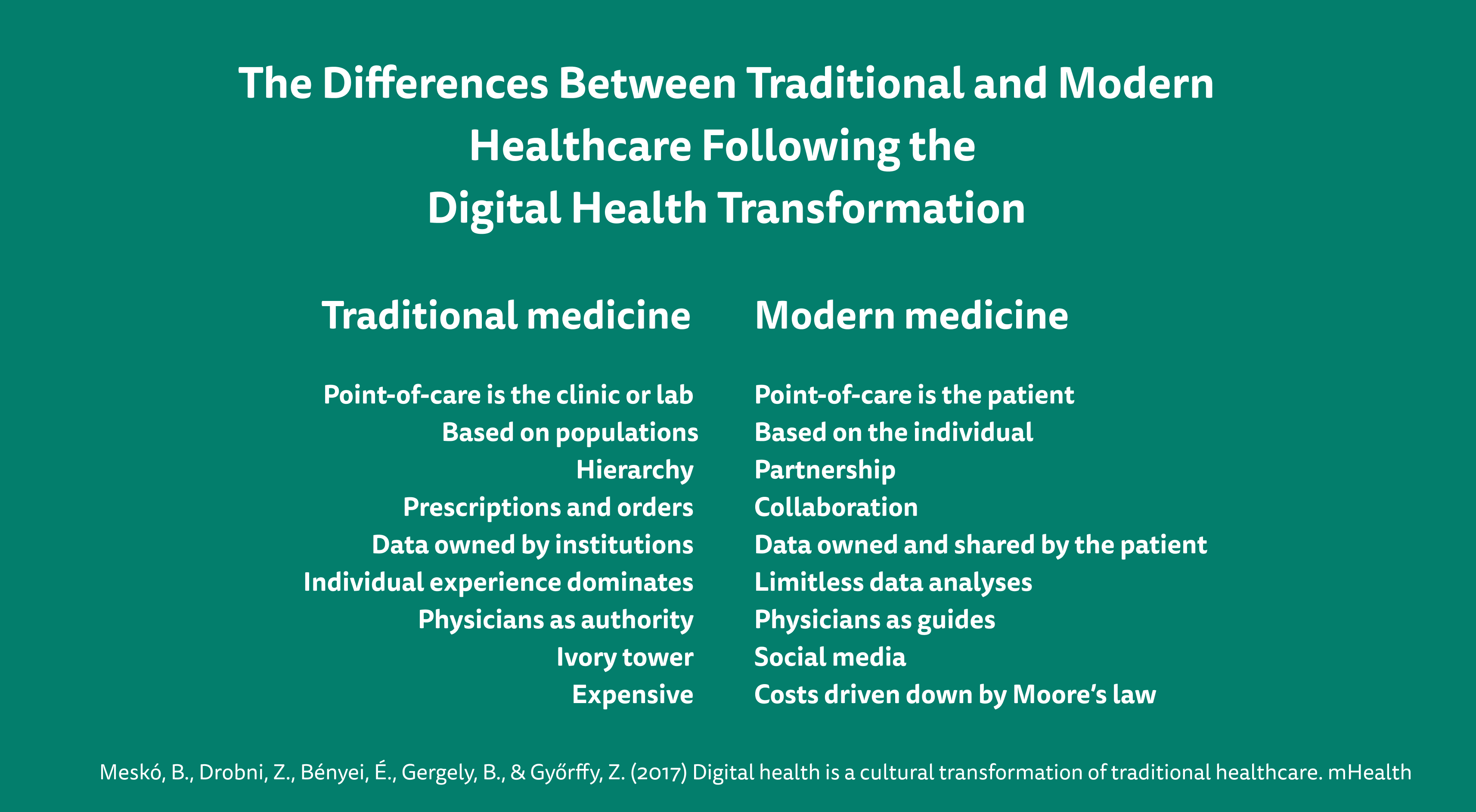Over the past decades, healthcare innovation has rapidly evolved. Information and communication technologies have become a key determinant of the quality of health services. Healthcare’s transformation is still ongoing but we are already seeing a successive shift from traditional medicine to modern medicine.
Health care spending
Over the past decades, life expectancy has increased globally. Despite all the healthcare innovation, one of the biggest challenges in healthcare are the ever-rising costs in the US and other countries.
In 2019, U.S. health care spending increased by 4.6%, reaching $3.8 trillion or $11,582 per person. As a share of the nation’s Gross Domestic Product, health spending accounted for 17.7%.
In 2019, health expenditure in Germany amounted to 410.8 billion euros, or 4,944 euros per person. The total health expenditure grew by 19.3 billion euros or 4.9% compared with 2018.
The past years highlighted the continuous rise of healthcare expenditure, passing the 400 billion euro threshold after having exceeded 300 billion euros only in 2012 and 200 billion euros in 1998. The time until the next 100 billion threshold is reached has thus halved since 1998 from 14 to 7 years. In 2019, health expenditure accounted for 11.9% of the gross domestic product. This proportion was by 0.2% points higher than in 2018.

Healthcare innovation and the shift to digital enable the transformation and optimisation of processes, the digital processing of documents and analysis of data in the cloud. The impact of digital transformation results in cost reduction in almost every business sector.
Yet, the costs of healthcare services continue to rise rapidly, while the cost of other goods and services rises much more slowly.
How can this be?
The health expenditure trap
According to economic theory, wages rise when there’s greater productivity; but a rise without an increase in productivity is referred to as “Baumol’s Cost Disease”.
In 1966, economist William J. Baumol illustrated this idea by using the example of a string quartet: While the productivity of a given quartet has not increased over time over the last two hundred years, the salary (in nominal and real terms) has increased dramatically.
» One way out of this trap is to turn services into goods. Employing a cobbler to make a pair of custom shoes, for instance, is expensive, so we buy factory made shoes: shoes as a good instead of as a service. In doing so, we accept some limitations: a finite set of styles and sizes to choose from; perhaps a less-than-perfect fit for each individual foot; limited styles and customizations — but with the positive trade off in favor of greatly decreased cost. In much the same way, we consume the “good” of the string quartet in the form of a digital recording of a musical piece, instead of the “service” of a live performance. In short, turning services into goods industrializes the process, increasing efficiency and reducing cost. «
Vijay Pande, general partner at Andreessen Horowitz
This phenomenon and the role that technology can play in addressing it have been discussed for a long time already in higher education (see for example The Cost Disease in Higher Education).
In healthcare, the need for professional, highly trained people performing services is undoubted. As a result, this cost “disease” has been accepted and treated as a given – a disease that seems to be incurable.
How to cure the incurable
The cure for the cost “disease” is to transform some of the industry’s professional human labour into something that can be manufactured, commoditised, industrialised, distributed and automated. This concept is not applicable the same way it is for other industries due to the significance of the individual human touch in healthcare.
The first step when it comes to the impact of digital solutions in healthcare is the streamlining of back-office processes that will free up enormous resources. For example, artificial intelligence can replace human labour involved in analysing bills and claims. Making healthcare systems more efficient that way, can reigning in expenditures.
However, this does not mean that healthcare and digitisation do not mix well. Much like in the field of education, digital applications can free healthcare professionals of tedious repetitive tasks. This allows them to focus on the kinds of care software cannot provide. Moreover, leveraging data collection and analytics capabilities will allow us to provide new forms of care that an individual professional couldn’t have possibly provided.
Healthcare innovation: cost-efficient, scalable and effective
It is essential to think about how and why digital healthcare services are established. Virtual doctor visits have proven to be immensely helpful during the pandemic. However, if we want to solve the cost “disease”, it is not sufficient to transform the physician-patient interaction.
If a healthcare service includes a human component, the scalability of the service is limited. For example, a psychotherapist can only treat a certain number of patients each day, no matter how efficient the processes and services are organised. Hence, the degree to which providers are involved in the delivery of the service, determines how scalable the approach can be.
If we want to solve “Baumol’s Cost Disease”, we need to transform (at least some) services into goods and find effective, cost-efficient and scalable ways to deliver care.
As a result, clinical efficacy, cost and scalability are three important concepts to keep in mind in healthcare innovation for addressing health systems’ challenges.
As pointed out in our article on the mental health landscape, existing offerings – particularly in the field of mental health – often do not meet the demand. Furthermore, current (mental) healthcare services are not flexible enough and cannot easily be scaled up. Consequently, it appears attractive to complement existing offerings with digital tools and solutions which are safe or at least low-risk, effective, scalable and efficient, such as digital therapeutics.
Digital therapeutics: an outstanding progress in healthcare innovation
Digital therapeutics deliver evidence-based therapeutic interventions to patients. High-quality software programmes prevent, manage, or treat a medical disorder or the side effect of a somatic disease. Scientific research has generated a comprehensive body of evidence over the course of the last twenty years that digital mental health treatment programmes can indeed be very effective. Given the enormous challenges that global mental healthcare is facing, digital therapeutics thus are a viable instrument to close the existing care gaps.
The accessibility of these digital interventions allows patients to speed up initial treatment contact and thus, prevents or reduces chronification. In addition, research found that many people with mental health problems would like to deal with their mental stress and symptoms on their own first, before reaching out to a professional for help.
Digital therapeutics have low barriers to entry, are available anytime, anywhere and thus are a great first touchpoint for those seeking help. They can also provide much-needed support as people wait to begin face-to-face psychotherapy. In the future, we believe, they will also complement and enhance face-to-face psychotherapy sessions, allowing therapists to provide a broad range of highly modular forms of blended care.
We hope that this article was insightful for you! We will be sharing each of our articles on our LinkedIn page to further engage with the HelloBetter community. Hence, we invite you to share your perspective on this topic and post your experiences in the LinkedIn comments.
We are looking forward to exploring with you how digital mental health solutions will redefine the future of care.
About HelloBetter
HelloBetter is a global pioneer in the field of digital mental health. No other provider worldwide has conducted as many clinical studies on the effectiveness of its online mental health courses. With our unrivalled scientific expertise (30+ RCTs) and passion for supporting people with mental health problems, we have already helped tens of thousands of patients to lead better lives. Find out more about HelloBetter on our Company page.
With HelloBetter Insights we want to share our learnings and analysis with the broader mental healthcare community. Every week, we will survey the ecosystem, report on promising developments, but also highlight the tough challenges that the industry is facing.
